Results 1 to 15 of 18
-
24th June 2008, 01:45 PM #1
 Restoration of a walnut chest on stand.
Restoration of a walnut chest on stand.
This c.1695 William and Mary walnut chest on stand was badly damaged and on first appearances looked quite hopeless, but a lot worse than this has been dragged back from the brink!
Some of the cross-grain mouldings were missing as were three of the legs. These were replaced using English walnut of the same general grain and colour.
The stand in several pieces.
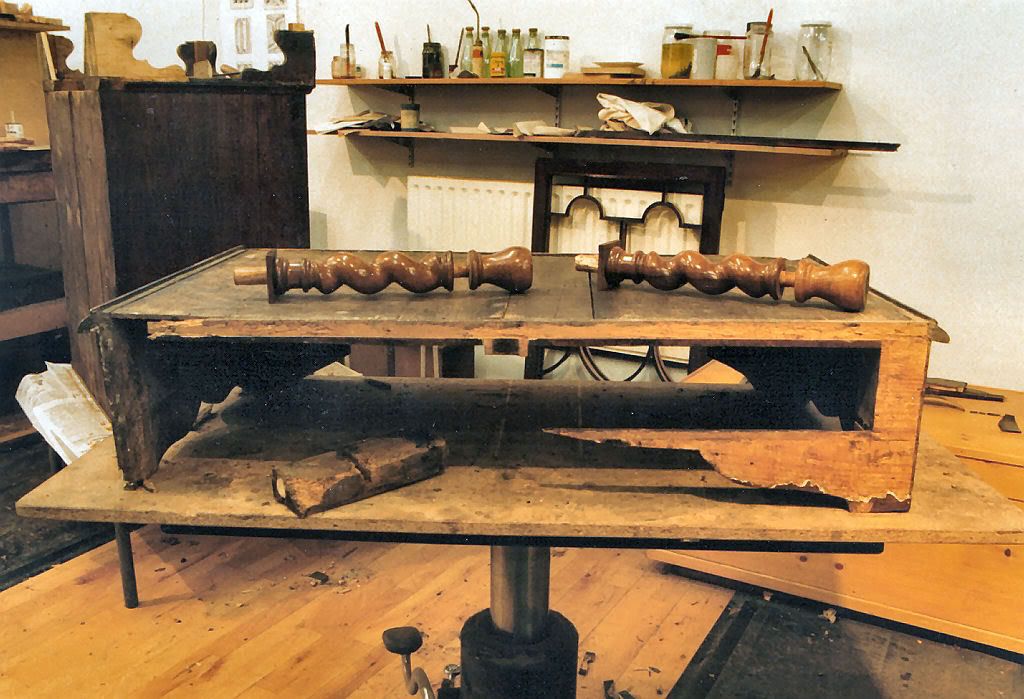
The chest looking a little sad.
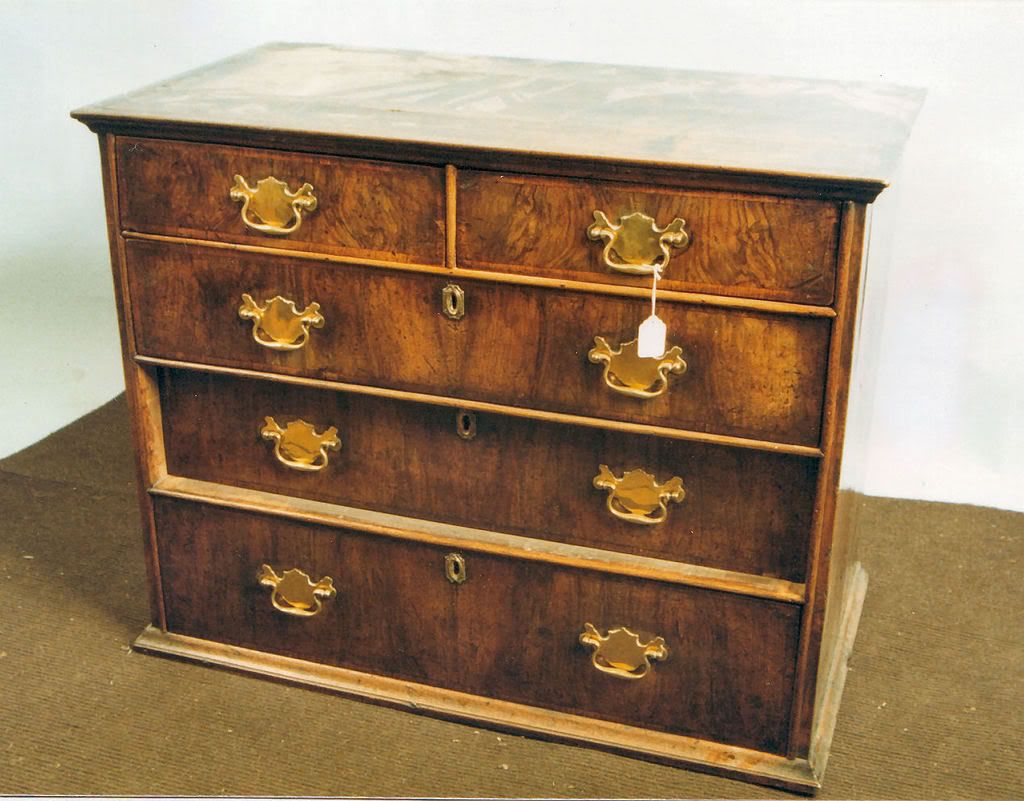
As is common with pieces of furniture this age, the handles have often been replaced; sometimes due to broken or incomplete sets and sometimes because of changes in fashion. The Victorians had a detestable habit of replacing perfectly good handles with hideous, bulbous big wooden knobs. The brass handles that arrived on the chest were poor quality 20th century replacements and stylistically, wholly inappropriate for the period.
The picture below shows the evidence of four previous replacement sets of handles. As the period-correct drop handles only cover a small area, the old handle scars needed to be removed.

The front apron of the stand was rebuilt using old pine and new sections of cross-grain mouldings were made up.
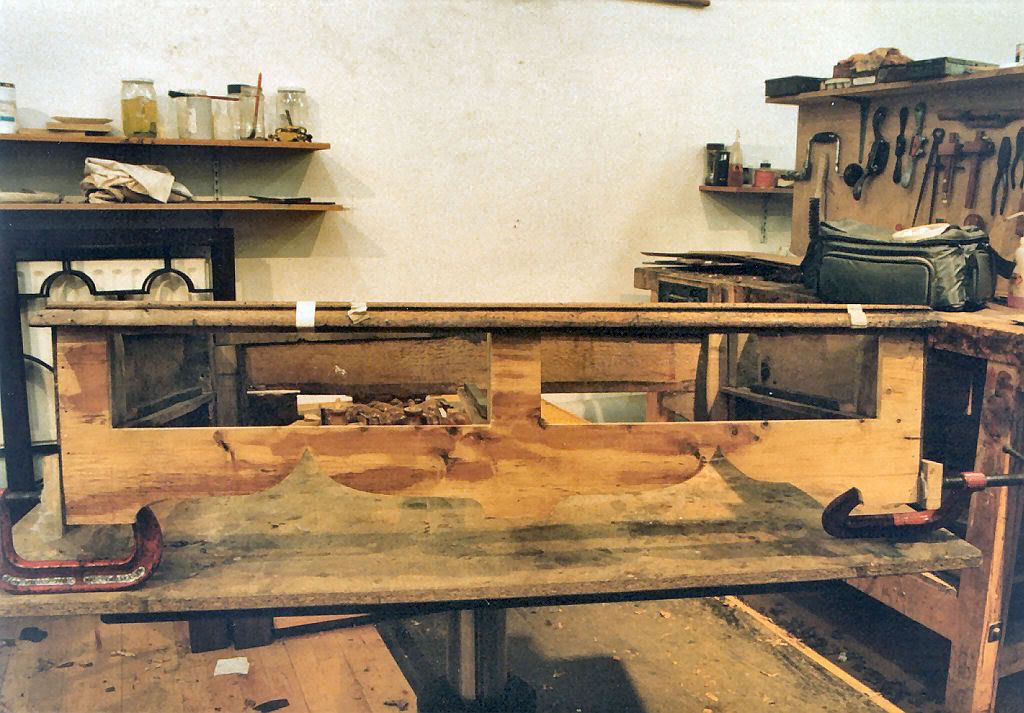
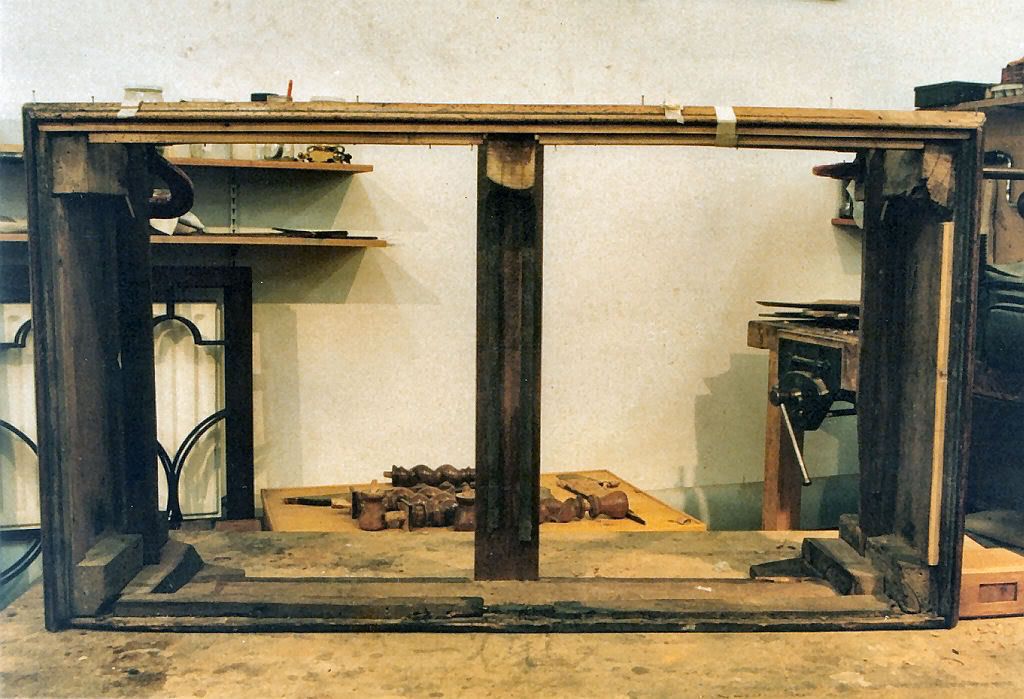
A new wavy stretcher had to be constructed from pine and veneered with walnut as the original one hadn't survived.
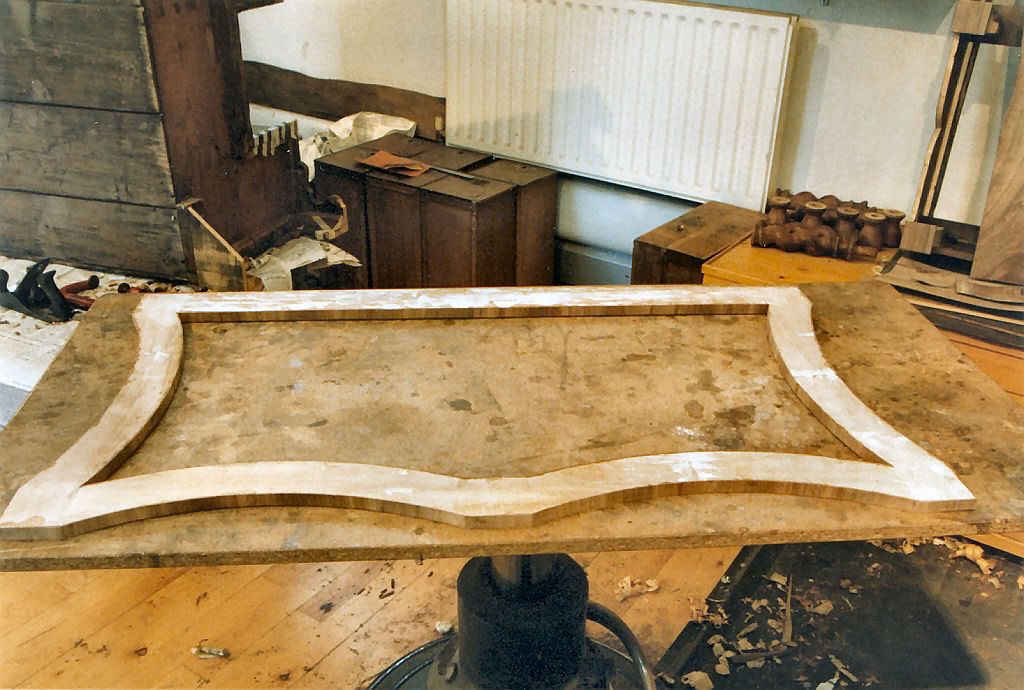
The front of the stand was veneered with thick, hand cut walnut veneer and the absent legs were turned from solid walnut.

Half inch wide cross-grain 'D' mouldings were made up and applied around the drawer openings. The drawers were reconstructed and missing veneer and crossbanding replaced.
A full set of original handles and escutcheons weren't available, so a set was cast from original inventory samples using the correct brass alloy of the period. The handles were then aged and flat steel 'wires' were made to attach them with.
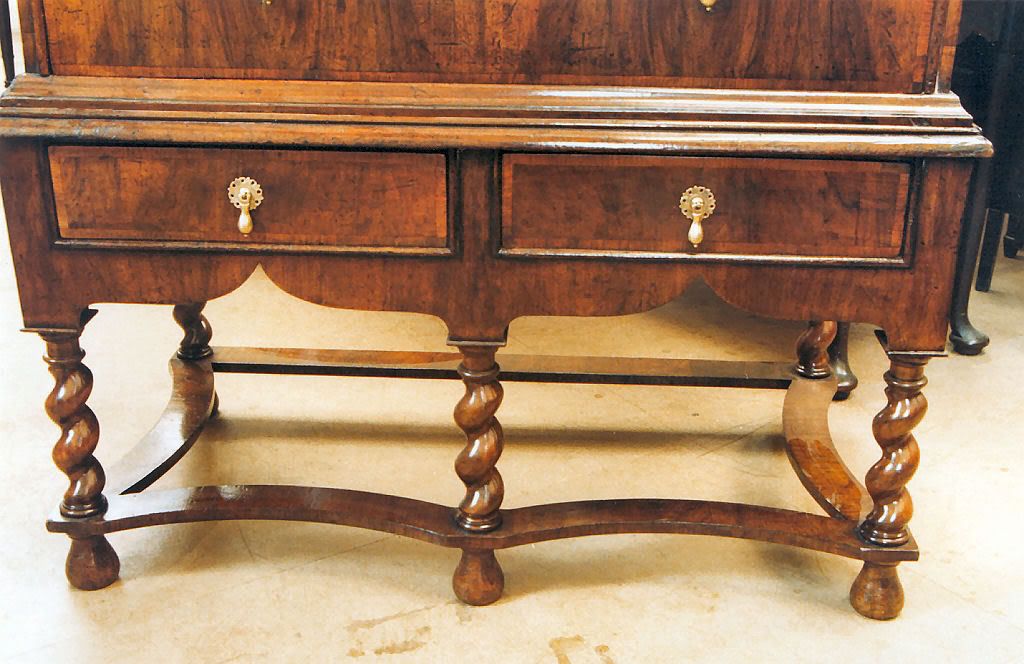
The chest was fully restored including new drawer runners. The whole piece was coloured and polished before finally fitting the new drop handles.
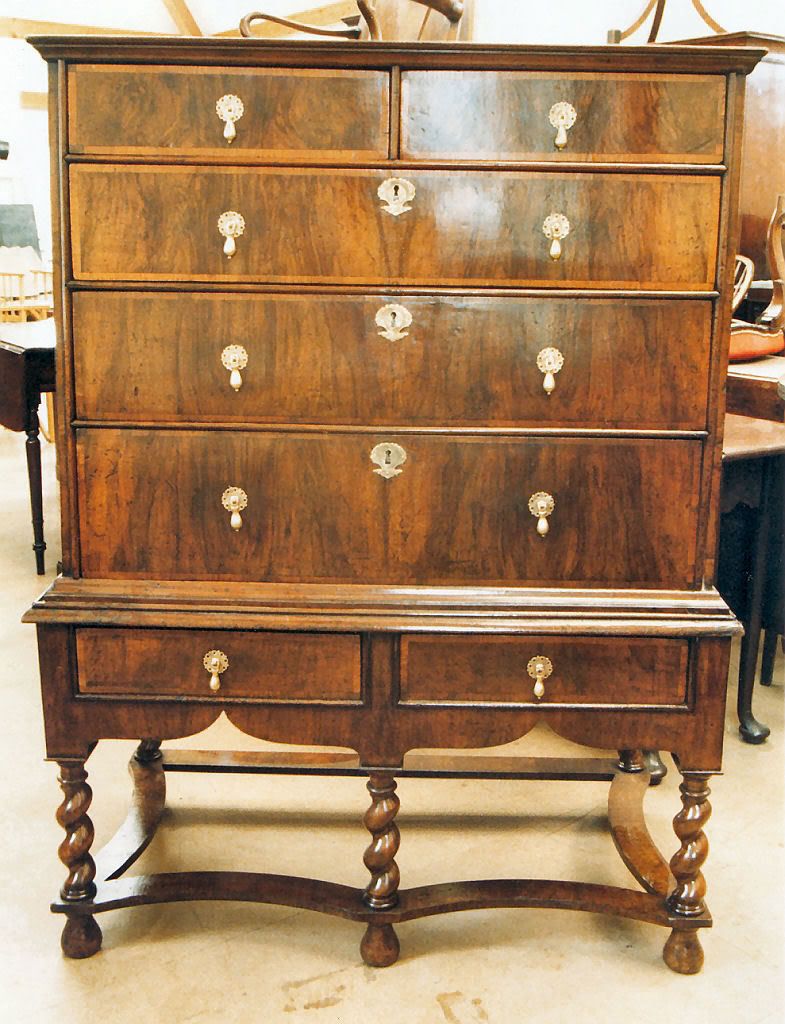
.
I know you believe you understand what you think I wrote, but I'm not sure you realize that what you just read is not what I meant.
Regards, Woodwould.
-
24th June 2008, 09:41 PM #2

You must have done something saintly in a previous life to have earnt the opportunity to do work like this! You certainly do it justice.
Your work is truly an inspiration.
Now, when are you starting that book? Or at least a website... It would be criminal not to preserve a record of your work for future (and present) generations.Cheers, Richard
"... work to a standard rather than a deadline ..." Ticky, forum member.
-
24th June 2008, 10:29 PM #3

Yes thanks for sharing wonderful result.
Mike
-
24th June 2008, 10:43 PM #4
 SENIOR MEMBER
SENIOR MEMBER











- Join Date
- Sep 2007
- Location
- Melbourne
- Posts
- 0

Hi Woodwould,
Another example of truly wonderful restoration work with careful attention to the original detail.
A question... what methods do you use to repair badly worn drawer carcasses and slides?
Cheers,
Chipman
-
25th June 2008, 08:13 AM #5

There are so many different methods of chest and drawer construction that it's difficult to be specific without further details, but on this particular chest, the entire drawer divider is also the dust board and drawer runner all in one. These are the most difficult to restore and require complete removal from the chest.
It's not uncommon to find these dividers worn completely through a few inches in from the front edge. The remedy is to cut off the damaged ends and attach new wood with long scarf joints and then replace the (again, in this case) 'D' mouldings. All periods employed some form of moulding or veneer so disguising the scarf joint isn't difficult.
Some less conscientious restorers perform a temporary fix by gluing extra wide runners on the bottoms of the drawers to bridge the worn tracks in the drawer guides/dust boards/dividers. These wide runners usually wear quickly as the weight is still unsupported properly and often more damage is created.
The drawer runners need to be carefully planed/chiselled away and new runners of the same wood, grain orientation and dimensions grafted on. When done correctly, the runners shouldn't be noticeable viewed from the side when the drawers are pulled out. Drawer runners should never be waxed; timber will burnish itself perfectly well on its own, providing enough slip. If wax is introduced, it will eventually permeate the guides and runners making future gluing operations very difficult..
I know you believe you understand what you think I wrote, but I'm not sure you realize that what you just read is not what I meant.
Regards, Woodwould.
-
25th June 2008, 10:06 AM #6
 .
.
I know you believe you understand what you think I wrote, but I'm not sure you realize that what you just read is not what I meant.
Regards, Woodwould.
-
25th June 2008, 09:42 PM #7

Well if its help you're after, you've come to the right place! I can't help with photography or workshops as I'm in the wrong city, but I'm happy to proof read!
Cheers, Richard
"... work to a standard rather than a deadline ..." Ticky, forum member.
-
25th June 2008, 10:47 PM #8
 SENIOR MEMBER
SENIOR MEMBER











- Join Date
- Sep 2007
- Location
- Melbourne
- Posts
- 0

Hi Woodwould,
Thanks for the information about the drawers, it has been a bit of a busy day today so It has taken awhile to get to the forum.
We all hope you do your books!
Regards,
Chipman
-
26th June 2008, 12:09 AM #9
-
26th June 2008, 12:16 AM #10
-
29th June 2008, 02:23 AM #11
 Happy Feet
Happy Feet











- Join Date
- Sep 2007
- Location
- Armadale
- Posts
- 887

I've got a good stock of old handles, not genuine of course, but worn georgian
repros. also for campain chests, nice battered brass cup pulls etc
If you want some for your next job PM me.
Astrid
-
29th June 2008, 11:33 AM #12
-
29th June 2008, 03:26 PM #13
 Skwair2rownd
Skwair2rownd











- Join Date
- Nov 2007
- Location
- Dundowran Beach
- Age
- 77
- Posts
- 0









-
29th June 2008, 10:33 PM #14

as usual, another brilliant thread Woodwould



and as Rhancock says, Your work is truly inspirational
-
30th June 2008, 08:46 AM #15
 restoration.
restoration.
WW, your talent makes me green with en vie. That is a truly great restoration.







Similar Threads
-
Best for walnut
By Paul1234 in forum FINISHINGReplies: 1Last Post: 29th March 2006, 11:39 AM -
walnut oil
By cliff cook in forum FINISHINGReplies: 0Last Post: 25th April 2001, 12:42 AM





 Reply With Quote
Reply With Quote









Bookmarks